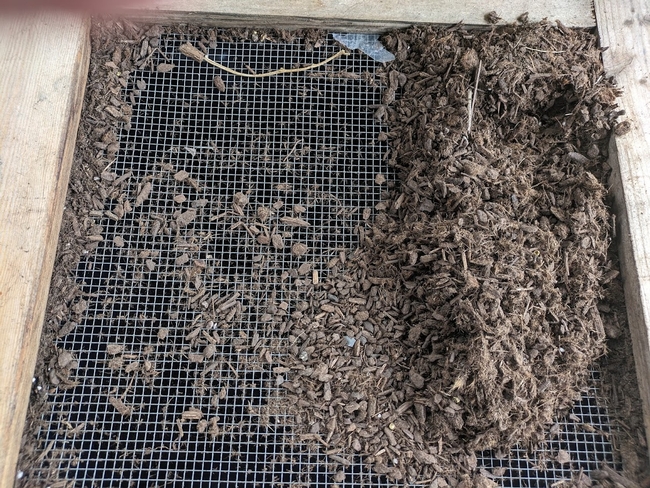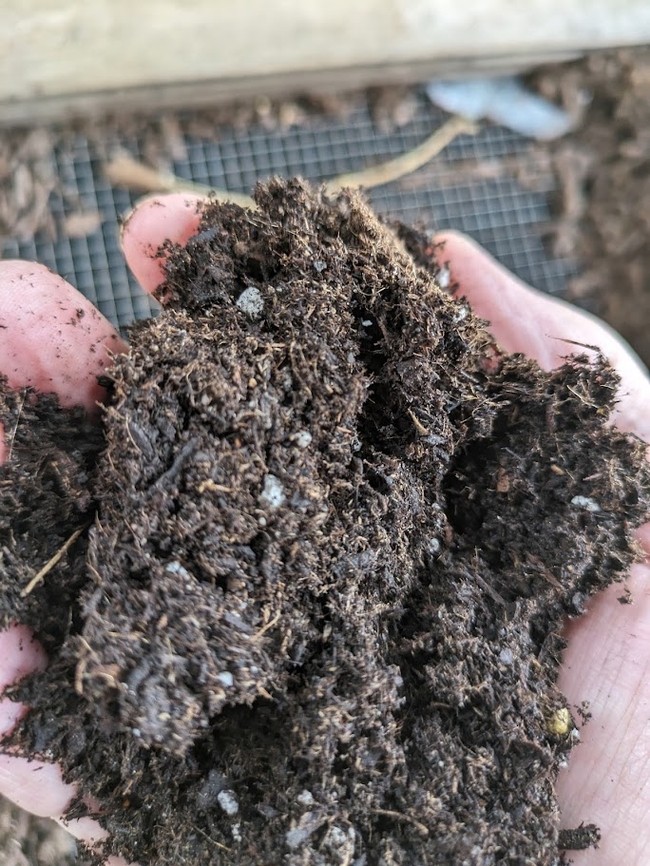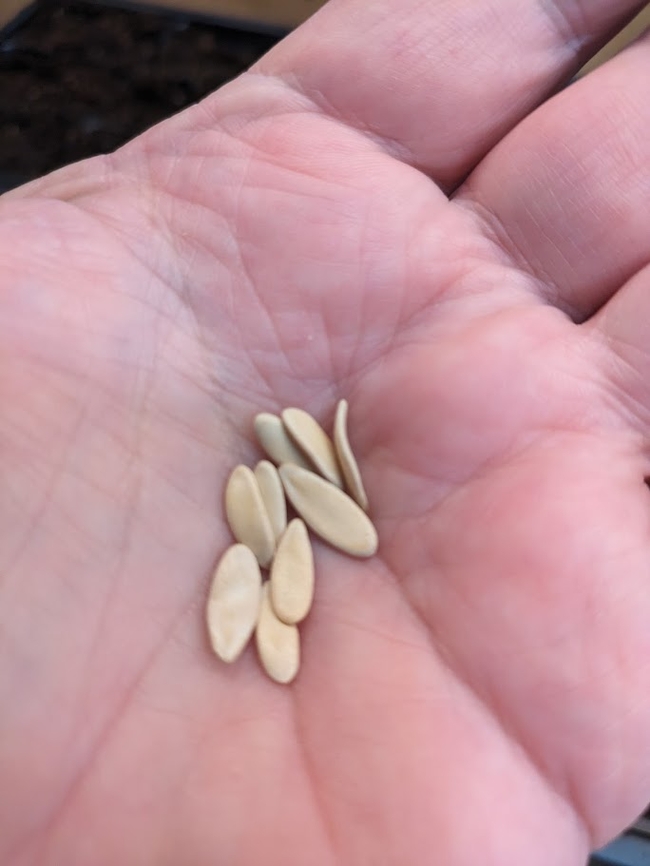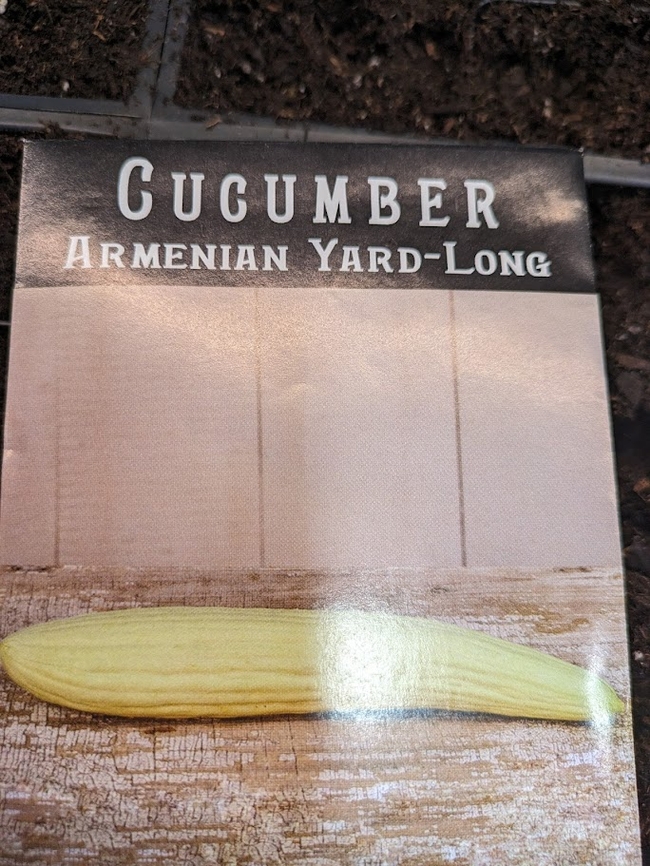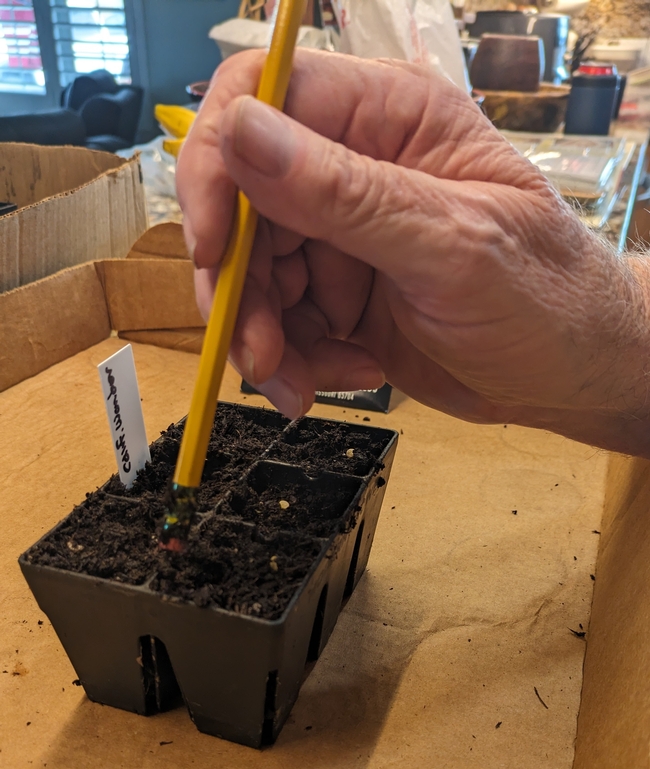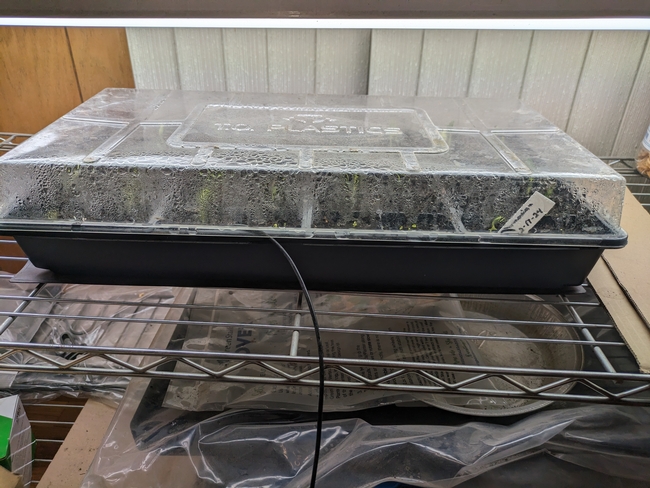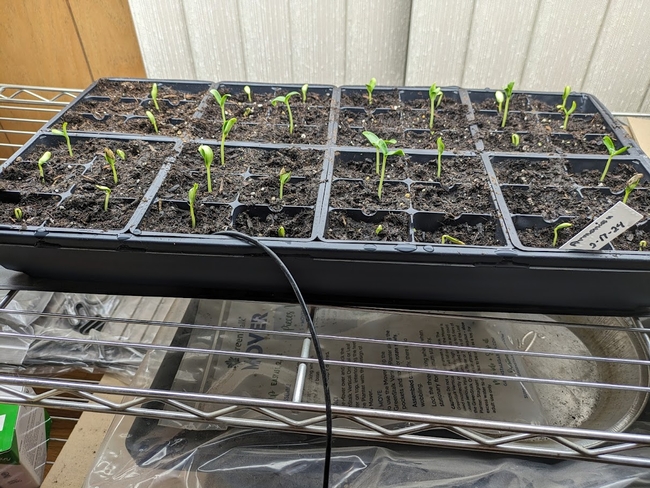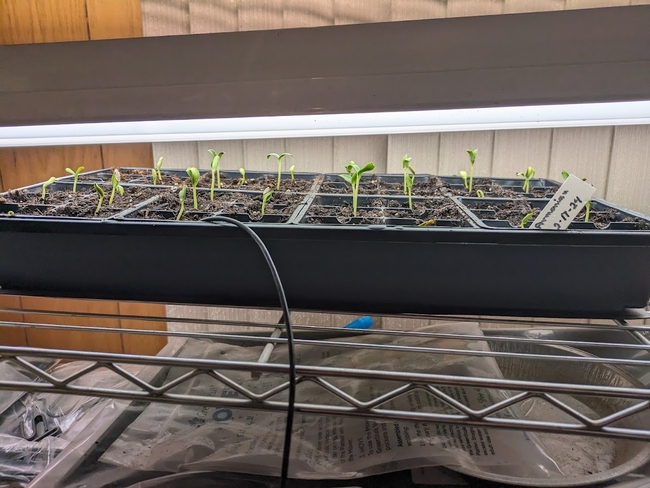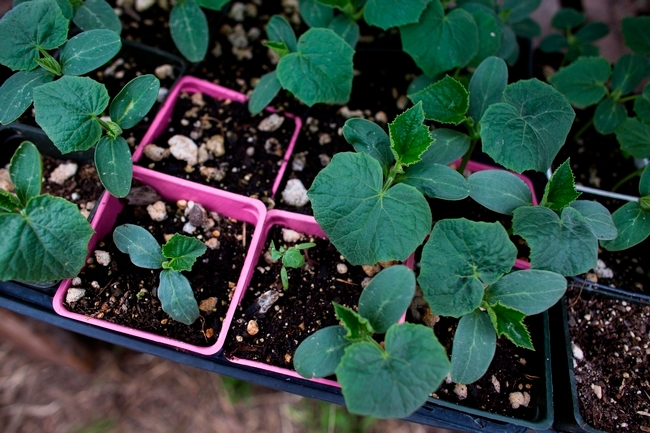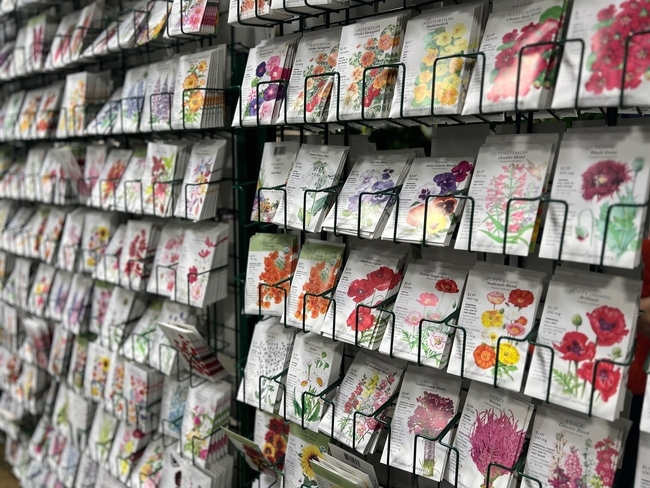We are getting close to the typical average last frost date at March 3rd. So now is the time to start some cucumber, squash or melon seeds indoors.
Starting Mix
First, you need some seed starting mix. You can use ready-made mixes, or you can make your own by using potting soil mix you have on hand. Since I always have some potting soil mix on hand for use in containers or up potting starts, I use that. I suggest screening it through a ¼ inch hardware cloth sieve to take out any larger pieces which might block the seeds from poking through the mix.
Once the soil is hydrated, add it to the seed trays. Since cucumber, squash, and melon seeds are larger seeds, they are planted at about twice their size or roughly ½ inch depth.
Next, place your starter tray on a rack or designated place, covering it with a humidity dome. If you have plant-start heating mats, they can be very helpful by warming the soil, but are not absolutely necessary. It is customary to “bottom” water seeds, so add water to the tray your seeds are in. The soil should be moist enough from the initial wetting process described above, thus only a little water should be needed in the tray. Add water only when soil dries out slightly. After about 15 minutes, if any water remains in the tray, drain it. The humidity dome should stay on until the seedlings begin to show.
Seedlings
The Armenian cucumber seeds in these photos germinated over five days from February 17th through the 22nd with the humidity dome being removed on February 22nd.
At this point the seedlings should be placed under grow lights slightly above their height. Adjust the height of the light as the seedlings grow. If the grow lights are too high, the seedlings will likely become “leggy,” because they are stretching to reach more light. This will cause them to be weaker due to the main stem being too long and thin, and likely top heavy. The first set of leaves on the seedlings are the cotyledon leaves. The next set of leaves you will see are the first true leaves and the cotyledon leaves will likely drop off.
Preparing Plants for the Garden

Hardening off is the process of acclimating the new seedling to the outdoors. This starts by moving them outdoors the first day for perhaps 2 hours. This continues daily, increasing amount of time of outdoor exposure each day for about 1 week. By then your new starts should be able to handle being transplanted into your outdoor garden.
If you prefer not to jump start your growing season by starting seeds indoors, cucumbers, squash, and melon seeds can be started in the ground in late March. Just be sure to check the long-range weather forecast to see if any possible freezing temperatures might happen.
Tim Long has been a UC Master Gardener in Stanislaus County since 2020. All photos are by the author.
- Author: Denise Godbout-Avant
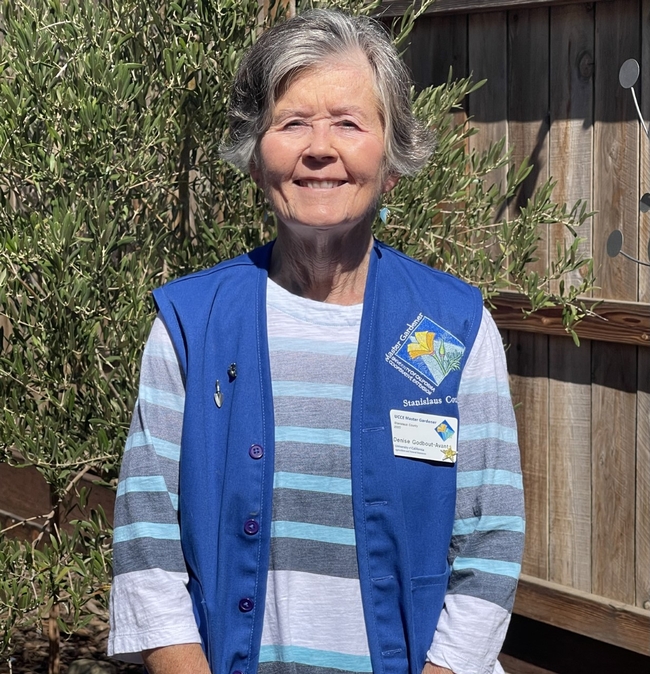
Pepper seedlings take anywhere from one to six weeks to germinate, depending on the variety. When the weather and soil are warm enough, if you want to have pepper plants ready plant in your garden, now is the time to start the seeds.
This is part one of a two-part series. This article focuses on growing and caring for your pepper seeds. The second article will cover potting the seedlings, “hardening-off,” and transplanting them into your garden.
What Is Needed
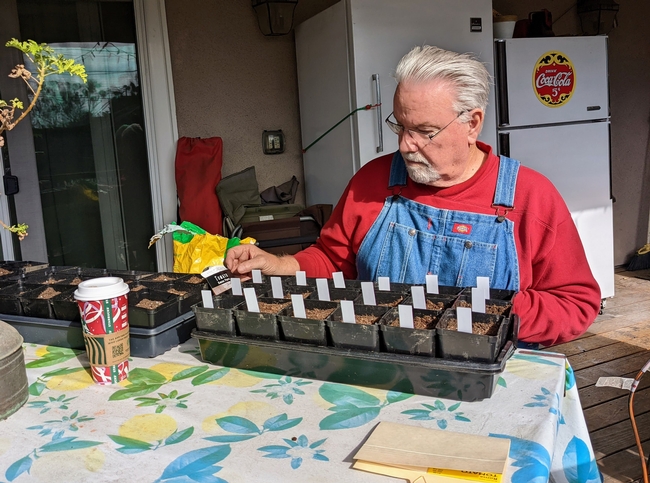
- 6-pack seedling tray(s) with a clear lid (humidity dome)
- Good quality seed-starting soil
- Seeds
- Water
- Heat mat (optional, but very helpful)
- Grow lights and timer
- Liquid plant starter fertilizer
- Oscillating fan (helpful, but not required)
- Latex gloves (if planting hot peppers, but not needed with dry seeds)
Beginning Steps: Planting the Seeds
- Fill clean seed trays with damp seed starting soil.
- If using new seeds, plant one/cell; if older or have low viability rate, plant 2-3 seeds/cell. Follow instructions on the seed packet, but the rule of thumb is planting depth is twice as deep as the seed is wide. For pepper seeds, this would be about ¼ inch deep. Cover the seeds with soil.
- If the soil is not already wet, add water. It is best to always water from the bottom so not to disturb the seed. Add enough water into tray until it is about ¼ inch. Do not overwater! Dump out any excess water that has not been absorbed in 15 minutes. Peppers dislike soggy roots, so let the soil dry out a bit between watering.
- Cover the tray with the clear dome lid to help keep the soil warm and moist.
- Place the tray in a warm spot. It is recommended to put it on top of a heat mat, which provides a consistent heat source and helps speed up germination. The ideal temperature is 80-90°F. If it is too cold the seeds may not grow.
- Once the seedlings sprout, remove the dome cover and turn off heat mat.
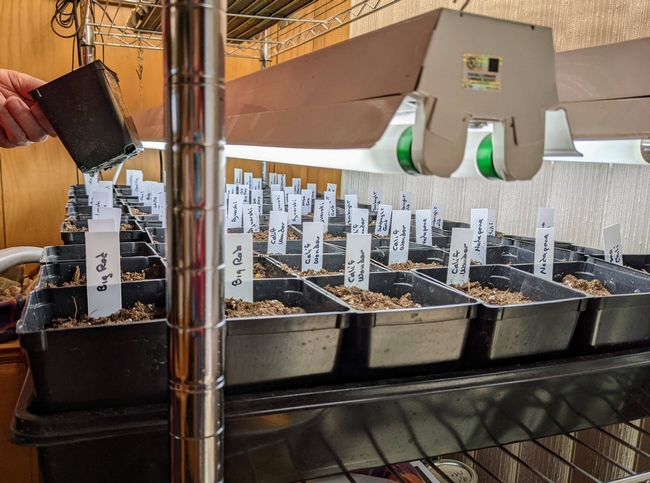
Pepper Seedlings Care: Light, Fertilizer and Air Circulation
- The seedlings need to be watered consistently, but do not like wet soil. Always water from the bottom. Allow the soil to dry out a bit between waterings, but keep it moist, never letting it dry out completely.
- Provide light as soon as they germinate! If pepper seedlings do not get enough light, they will get “leggy” because they are reaching for a light source. To keep them thick and compact, it is best to use a grow light, which is hung up a few inches above the tray and keep it on for 14-16 hours per day. The light should be close to the plants, but not touching. As they grow, move the light higher.
- Once the true leaves begin to form, it is time to start fertilizing using a liquid plant starter fertilizer. Following label directions, start with a weak dose at first, gradually increasing as the seedlings get larger.
- Once most or all the seeds in a flat have germinated, they need to have some airflow, so remove the plastic lids and run an oscillating fan over them on the lowest setting for a few hours each day (you can plug it into the same timer being used for the grow light). An alternative to the fan is to gently brush your hands over the top of the seedlings a few times each day. This will strengthen them and prevent mold in the trays.
Some pepper varieties grow faster than others, but in one to six weeks, your pepper plants will have started to outgrow the trays. Now will be the time for the next steps of transplanting to pots, “hardening” them (a vital step!), and finally, planting into your garden. This will be covered in the second part of this article, which will be posted towards the end of February.
With thanks to Tim Long, UC Master Gardener, for his expertise on growing peppers from seedlings.
Author: Denise Godbout-Avant, UC Master Gardener since 2020
- Author: Melissa G. Womack
- Author: Skylar Peters
February is a great time to start preparing for your spring and summer vegetable garden, especially if you want to get a head start on the growing season. According to the California Master Gardener Handbook, growing your own transplants from seed indoors can extend your garden season by several weeks, reduce your gardening cost and allow you to grow a more diverse variety of crops.
Growing from seed is not only fun, but it can also save you money. When stored properly a typical seed packet can last several years. Seeds should be started indoors or in an outdoor hot box or cold frame. Start growing the seeds 6-8 weeks before the date you would like to transplant them and when the threat of frost has passed.
Another benefit of growing vegetables from seed is the wide selection of varieties available from seed catalogs. Growing different varieties is important for an extended harvest and to find plants that grow well in your area. Vegetable plants sold in seedling form are generally available in only one or a few varieties. Plants typically started by seeds indoors include broccoli, cauliflower, eggplant, parsley, tomatoes and peppers. Seeds typically started in the ground include beans, beets, carrots, peas and turnips.
What do you need to get started?
- Soil mix - The soil media you choose should be fine textured, uniform and airy. Do not use garden soil. It is usually too heavy and often may have disease-causing organisms. A commercial potting mix suited to starting seeds will work well. Fill your growing containers about 2/3 full.
- Containers - You can start seeds in almost any container that has drainage holes. Sterilize recycled containers in a 1:9 bleach to water solution, rinse them well and let them air dry prior to use.
- A location with proper light and temperature - A sunny window is usually the perfect spot as it has strong but indirect sunlight. Seed packages should instruct you on sunlight needs. Additionally, keep your seedlings in an area that stays between 65 and 70 degrees during the day and 55-60 degrees at night.
- Quality Seeds – Only plant seeds from a reputable source. Check your seed packets to ensure your seeds have not expired, and that you are planting them at the right time of year. You can also check for seed viability.
- Water – It is crucial to provide seeds with consistent watering. Seeds and seedlings must be kept evenly moist to thrive.
Steps to starting your vegetable garden indoors
- It is important to follow the instructions on your seed packet. Refer to the seed packet for the proper planting depth, plant spacing, and days to maturity.
- Once you have planted your seeds, water them and continue to do so consistently. The goal is to keep the soil evenly moist but not overly wet.
- Two weeks before transplanting, or when your plants are two to four inches tall, expose them to outdoor temperatures to acclimate them. Do this by leaving them outside in a shady spot during the day for a week, and bringing them inside at night. The following week, leave them outside in their containers during the day and at night, gradually exposing them to more sunlight. This process is referred to as hardening off.
- Transplant your vegetables into the garden, planting them at their original depth. Tomatoes can be an exception to this rule however, so consider this tutorial before planting tomato seedlings. Be sure to handle seedlings with care.
Ask your local UC Master Gardener Program
Have a seed starting or home vegetable gardening question? UC Master Gardener volunteers are available to help. Click here to Find a Program and connect with your local UC Master Gardener Program. You will be redirected to your local county website and contact information. UC Master Gardener volunteers are available to help answer questions for FREE. Happy gardening!
- Author: Denise Godbout-Avant
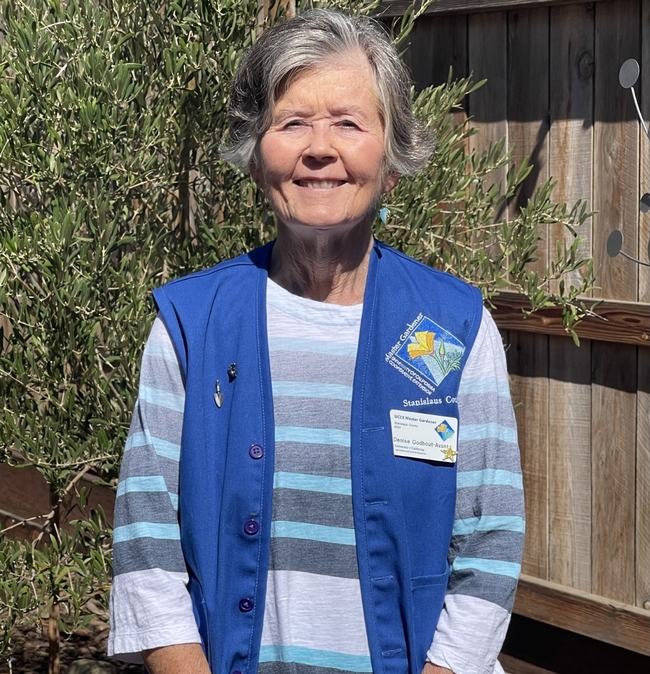
There are three groups of plants that attract birds and each group draws different types of birds: Nectar plants, plants that provide seeds or nuts, and plants that produce berries or fruit. Many plants will provide more than one source of food, i.e., nectar in the spring and berries in autumn.
Here is a list of a few favorite native plants in each group and some of the birds they may attract.
Hummingbirds and Nectar
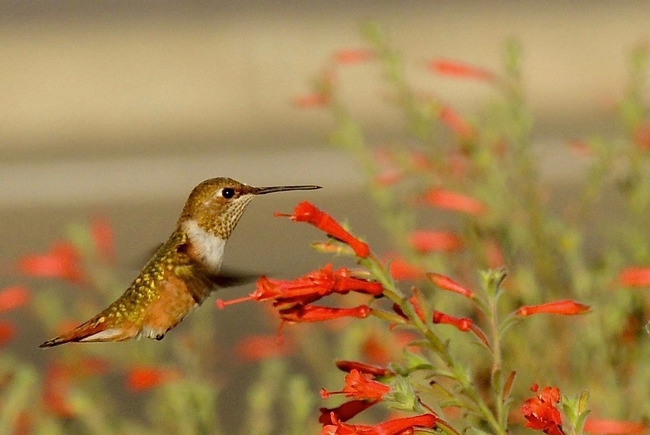
Hummingbirds prefer tubular shaped flowers that fit the length of their beak, and are bright in color, particularly red. Native salvias (sages), penstemon, columbine, and honeysuckle all serve up nectar for hummingbirds.
- Sages (Salvias): There are about 18 sages native to California, with Hummingbird sage (Salvia spathacea) being one of them. The common name says it all! Fruity scented dark rose-lilac blossoms appear in March – May. It also produces autumn seeds that attract birds such as sparrows and finches.
- Western Redbud (Cercis occidentalis). A small deciduous tree or shrub found in the foothills and mountains of California with distinctive shiny heart-shaped leaves. The showy bright pink or magenta flowers develop in the later winter and spring, growing in clusters all over the shrub, making the plant very colorful and noticeable in the landscape. Goldfinches and sparrows will feed on seeds produced in the fall.
- California Fuchsia (Epilobium canum). There's probably no better California native plant for attracting hummingbirds. A perennial plant, it blooms a bright profusion of scarlet flowers in spring and summer, and is often the only native California flowering plant blooming at the height of summer.
Birds That Eat Seeds
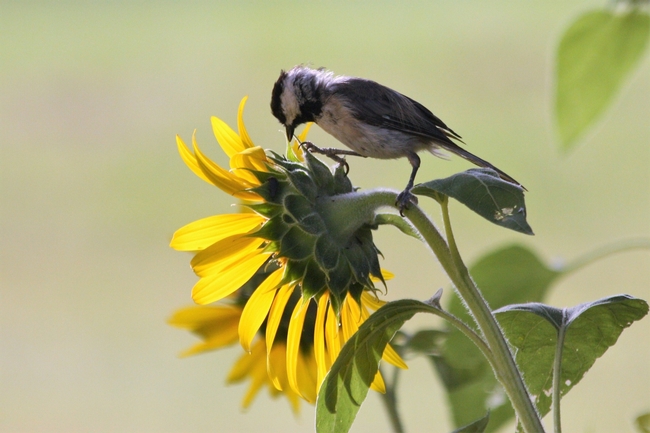
- Bush sunflower (Encelia californica), commonly referred to as "California bush sunflower.” With abundant bright yellow daises, it is beautiful in late winter through summer. Attracts goldfinches, sparrows, orioles, crows, Scrub jays, grosbeaks.
- California aster (Symphyotrichum chilense). A member of the Asteraceae family it is native to western North America. The summer blooming flowers come in blues, purples and yellow colors. It is also a host plant for the Northern Checkerspot, Field Crescent and Pearl Crescent butterflies.
- Deergrass (Muhlenbergia rigens), also known as Meadow Muhly and Deer Muhly, is a summer-growing, perennial bunchgrass whose seeds attracts woodpeckers, finches, grosbeaks, crows and jays.
Berry Plants are Important to Birds
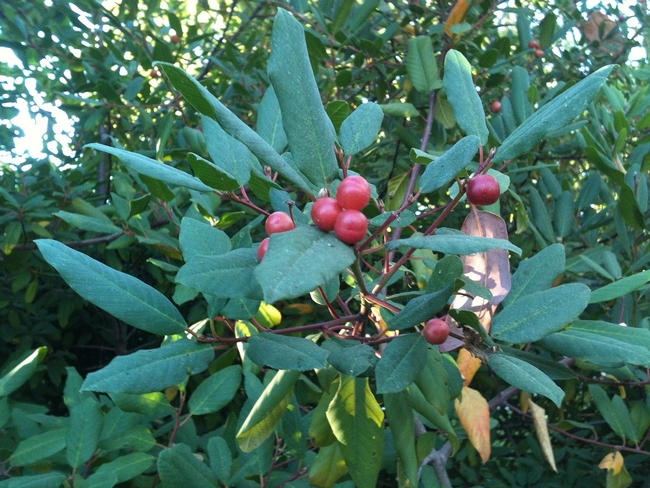
Many shrubs and small trees provide berries that ripen at different times, so providing a seasonal variety, such as cherries for birds during the breeding seasons of spring and summer, and holly in winter, helps sustain birds throughout the year.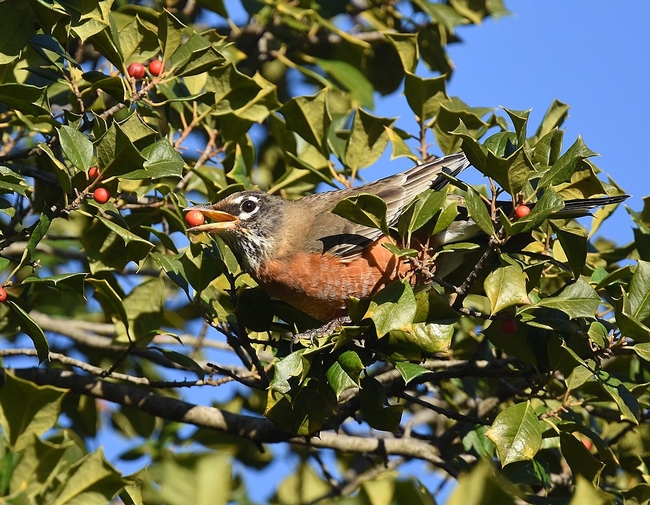
- Golden Currant (Ribes aureum). A deciduous plant that blooms in late winter and spring with golden yellow flowers that attract hummingbirds. The ripe berries in autumn are amber yellow to black in color, are edible, and attract a wide range of birds. There are two main varieties: Ribes aureum var. aureum and Ribes var. gracillimum.
- Blue Elderberry (Sambucus Mexicana). Also known as Mexican elderberry, the berries from elderberries are one of the most important sources of food for birds in California. Native from Oregon to Baja all the way to western Texas, it has cream or yellow flowers in the spring and purple berries in the fall.
- Toyon (Heteromeles arbutifolia). Toyon is a beautiful perennial chapparal shrub native throughout the western part of California and the Sierra foothills. It is also known by the common names Christmas berry and California holly from the bright red berries it produces during the winter months, which are produced in large quantities, maturing in the fall and persisting well into the winter. Note: the berries are toxic to humans in large amounts.
- California False Buckthorn (Frangula californica). This perennial, evergreen shrub is also known as Coffeeberry due to its berries containing seeds that resemble coffee beans. The shrub produces small, greenish white flowers in the summer, followed by dark berries that are sought after by birds.
By providing a variety of native plants that produce nectar, seeds and berries to attract different types of birds, you'll be providing a healthy haven for birds all year round, along with many other species of pollinators such as bees and butterflies!
Denise Godbout-Avant has been a UCCE Stanislaus County Master Gardener since 2020.
Resources
California Native Plant Society https://www.calscape.org/ and garden planner https://gardenplanner.calscape.org/
A list of plants that naturally attract California Birds to your Garden https://www.laspilitas.com/bird.htm
Audubon native plants database https://www.audubon.org/native-plants
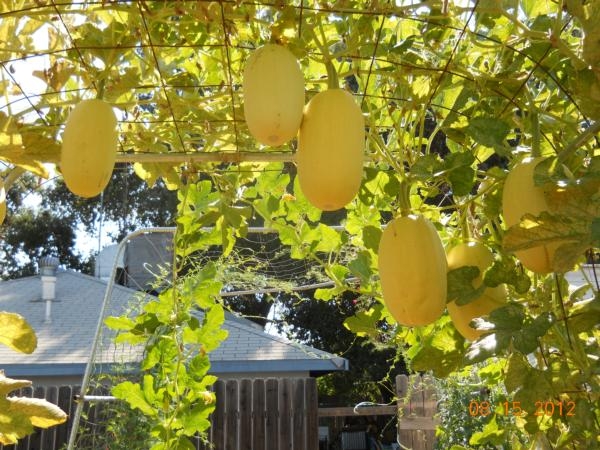
Now is the time to start thinking about which delicious vegetables you want to grow in your garden. Ted and Rho will go over all the possibilities with you in this class.
Spring Vegetables
These vegetables don't mind the cold and can be planted from seed in February. They may grow slowly, but as weather warms they will grow more quickly. Lettuce, Swiss Chard, arugula, mustard greens, and other leafy greens do well. Radishes, beets, carrots, turnips, and happy during this time as well. However, by late spring/early summer, many of these plants can't take the heat and may “bolt,” sending up flower stalks that the bees enjoy.
Summer Vegetables
You can plant these vegetables from seed or transplant in late March. They prefer warm weather and may “sulk” and grow very slowly if you plant them too early. These vegetables include melons, squash, winter squash, corn, tomatoes, and cucumbers.
Hope to “see” you there!

Where*: On Zoom. You will receive a link the morning of the class.
When: Tuesday, February 22, 2022 6:00-7:30 p.m.
Cost: Free
Register at: http://ucanr.edu/spring/veg/2022
Instructors: Master Gardeners Rho Yare and Ted Hawkins

